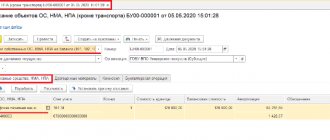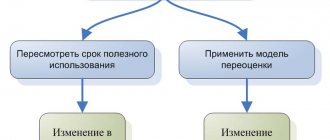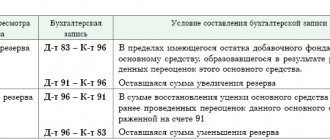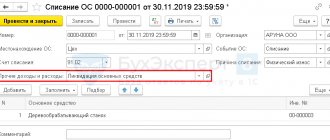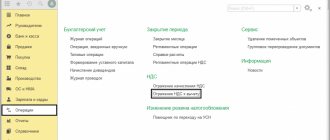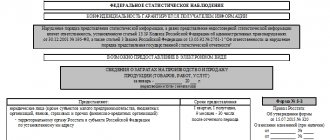Changing the tax regime is very popular: work on OSNO is complex and time-consuming, and control over the payment of VAT is increasingly strengthened. In this regard, changing the taxation regime from OSNO to simplified tax system looks very attractive.
After reading the article you:
- find out which document you cannot switch to the simplified tax system without, and learn how to create it in 1C;
- you will be able to perform all the necessary settings in 1C to switch to the simplified tax system;
- get acquainted with a special assistant in this transition - processing Assistant for the transition to the simplified tax system .
Rule 1 – for sellers (performers)
On the date of transition to the use of the simplified tax system (for example, in January 2017), it is necessary to include in income the amounts received before 2022 in payment under contracts that will be executed after the transition to the use of the simplified tax system (subclause 1, clause 1, article 346.25 of the Tax Code of the Russian Federation) .
First of all, we are talking about the amounts of advances received from buyers, customers and other counterparties. When working on the general taxation system, income is not reflected on the date of receipt of advances (subclause 1, clause 1, article 251 of the Tax Code of the Russian Federation). It is recognized upon the sale of goods, performance of work, provision of services (clause 1 of Article 271 of the Tax Code of the Russian Federation). But when applying the simplified tax system, the cash method is used, and “tax” income is recognized upon receipt of money (clause 1 of article 346.17 of the Tax Code of the Russian Federation).
So it turns out: if as of December 31 the seller (executor) received an advance payment, but did not fulfill the contract, then he has not yet reflected the income. And in January he is already working on the simplified tax system, which means he must include last year’s advance in “simplified” income, regardless of whether he fulfills the contract in January or later.
In this case, the important question is what to do with VAT. After all, when receiving the advance, the organization was still working on the general system and paid tax to the budget (subclause 2, clause 1, article 167 of the Tax Code of the Russian Federation). The deduction of this VAT is usually declared upon execution of the contract - after the shipment of goods, performance of work, provision of services. But in this case, this happens next year - after the transition from the OSN to the simplified tax system, when the organization ceases to be a VAT payer and loses the right to deduction (clause 1, 8, article 171 of the Tax Code of the Russian Federation).
The Tax Code of the Russian Federation dictates the following. The amount of VAT paid on the advance received before the transition to the use of the simplified tax system must be returned to the counterparty in the last quarter before the transition to the use of the simplified tax system. For example, you can conclude an additional agreement with him to the contract on changing the price of goods (work, services) by the amount of tax. And, having returned the VAT to the counterparty, in the same quarter you can claim this tax as a deduction (clause 5 of Article 346.25 of the Tax Code of the Russian Federation).
Read also “How to take into account income under the simplified tax system”
EXAMPLE.
INCOME IN THE FORM OF ADVANCE DURING THE TRANSITION FROM OSN TO STS Let's assume that an organization (performer) received an advance in November 2016 for the provision of services in the amount of 236,000 rubles, including VAT - 36,000 rubles.
Services were provided in January 2022 - after the transition to the use of the simplified tax system. The accountant will make the following entries: in November 2016: DEBIT 51 CREDIT 62 subaccount “Settlements on advances received”
- 236,000 rubles.
– the receipt of the advance is reflected; DEBIT 62 subaccount “VAT on advances received” CREDIT 68 subaccount “Calculations for VAT”
- 36,000 rubles.
– VAT is charged on the advance payment to the budget. in December 2016: DEBIT 62 subaccount “Settlements on advances received” CREDIT 51
- 36,000 rubles.
– VAT is returned to the customer; DEBIT 68 subaccount “Calculations for VAT” CREDIT 62 subaccount “VAT on advances received”
- 36,000 rubles.
– accepted for deduction of VAT on the advance payment, returned to the customer. in January 2022: DEBIT 62 subaccount “Settlements for services rendered” CREDIT 90-1
- 200,000 rubles.
(RUB 236,000 – RUB 36,000) – revenue from the provision of services is reflected; DEBIT 62 subaccount “Settlements for advances received” CREDIT 62 subaccount “Settlements for services rendered”
- 200,000 rubles. – the advance amount is offset against payment for services rendered. And for tax purposes, the organization recognizes “simplified” income in the amount of 200,000 rubles in January 2022.
Expenses
Organizations that used the accrual method must include unrecognized expenses paid during the period of application of the general tax system as part of the “transition” expenses. This is explained by the fact that with the accrual method, expenses are taken into account on the date of their implementation (clause 1 of Article 272 of the Tax Code of the Russian Federation). The date of payment does not affect the date of recognition of expenses. When simplified, the cash method applies (clause 2 of Article 346.17 of the Tax Code of the Russian Federation). With it, expenses are formed as they are paid. Moreover, additional conditions have been established for the recognition of certain types of costs.
Advances issued during the period of application of the general taxation system against future deliveries (excluding VAT) should be included in the single tax base on the date of receipt of goods (work, services). At the same time, take into account the restrictions associated with the write-off of purchased goods and fixed assets. Include paid but unrecognized expenses as expenses as the conditions under which they reduce the tax base for the single tax are met. Such rules are provided for in subparagraph 4 of paragraph 1 of Article 346.25 of the Tax Code of the Russian Federation.
Situation: is it possible for an organization to take into account rental costs in a simplified manner? The rent was paid in advance for several years in advance during the period of application of OSNO (before the transition to the special regime) /
Yes, you can.
Expenses for renting an office, which the organization paid using the accrual method, are taken into account when calculating the single tax on the date of their implementation (subclause 4, clause 1, article 346.25 of the Tax Code of the Russian Federation). Reduce the tax base monthly as you actually receive services under the lease agreement. A similar point of view is reflected in the letter of the Ministry of Finance of Russia dated November 14, 2005 No. 03-11-04/2/132.
An example of accounting for rental expenses paid before the transition to the simplified system. The organization pays a single tax on the difference between income and expenses
Alpha LLC rents office space. The lease agreement was concluded for the period from January 1, 2016 to December 31, 2022 inclusive (24 months). The amount of rent for the entire term of the contract is 480,000 rubles.
In December 2015, Alpha applied the general taxation system and calculated income tax on an accrual basis. This month, the organization transferred the entire amount of rent for two years in advance to the landlord.
Since January 2016, Alpha switched to a simplified version. The object of taxation is “income reduced by the amount of expenses.”
Starting from January 2016, the organization’s accountant monthly reduces the tax base for the single tax by the amount of rent in the amount of: 480,000 rubles. : 24 months = 20,000 rub.
Accounts payable for expenses that were taken into account when calculating income tax do not reduce the tax base for the single tax. Amounts paid to repay this debt after the transition to the simplified system cannot be re-included in expenses. For example, if unpaid goods were sold before the transition to the simplified system, then there is no need to take their cost into account when calculating the single tax after payment. This follows from subparagraph 5 of paragraph 1 of Article 346.25 of the Tax Code of the Russian Federation.
Situation: is it possible for an organization to take into account in a simplified manner the income tax and VAT accrued for the period in which the organization applied OSNO? Taxes were transferred to the budget after the transition to simplified taxation.
No you can not.
Any expenses named in paragraph 1 of Article 346.16 of the Tax Code of the Russian Federation can be recognized only if they meet the criteria specified in paragraph 1 of Article 252 of the Tax Code of the Russian Federation (Clause 2 of Article 346.16 of the Tax Code of the Russian Federation). That is, regardless of classification, the expenses specified in paragraph 1 of Article 346.16 of the Tax Code of the Russian Federation reduce the tax base for the single tax if they:
- documented;
- economically justified;
- are associated with activities aimed at generating income;
- are not named in Article 270 of the Tax Code of the Russian Federation.
Payment of income tax and VAT on obligations that arose during the period of application of the general taxation system cannot be recognized as an expense that meets the criteria of paragraph 1 of Article 252 of the Tax Code of the Russian Federation. After the transition to a simplified procedure, this operation is no longer associated with activities aimed at generating income, therefore, it is not economically justified. In addition, amounts of income tax and VAT accrued for payment to the budget cannot be taken into account for taxation due to the provisions of paragraphs 4 and 19 of Article 270 of the Tax Code of the Russian Federation.
Thus, an organization that has switched to a simplified tax system has no reason to reduce the tax base for a single tax by paying taxes accrued during the period of application of the general taxation system. The validity of this conclusion is confirmed by letters from the Ministry of Finance of Russia dated October 16, 2007 No. 03-11-05/251, dated December 19, 2006 No. 03-11-04/2/281.
Rule 2 – for sellers (performers)
Money received after the transition to the use of the simplified tax system (for example, in 2022) is not included in income if these amounts are reflected in income before the transition to the use of the simplified tax system (subclause 2, clause 1, article 346.25 of the Tax Code of the Russian Federation).
Read also “What income cannot be taken into account under the simplified tax system”
A common situation is receiving payment in 2022 for last year’s or earlier sales of goods, works, and services. The following is important here. If until 2022 the organization worked on a common system, then by the time it switched to using the simplified tax system it had already recognized income from sales. Therefore, when receiving payment, there is no need to recognize the same income within the simplified tax system again - upon receipt of money.
Fortunately, there are no VAT difficulties in this situation.
The tax must be accrued and paid to the budget in the usual manner - upon shipment, during the period of work on the general taxation system. EXAMPLE.
LACK OF INCOME WHEN TRANSITIONING FROM OSN TO STS Let's assume that an organization (performer) sold goods in November 2016 in the amount of 236,000 rubles, including VAT - 36,000 rubles.
Payment was received in January 2022 - after the transition to the use of the simplified tax system. The accountant will make entries (we do not consider writing off the cost of goods): in November 2016: DEBIT 62 CREDIT 90-1
- 236,000 rubles.
– revenue from the sale of goods is reflected; DEBIT 90-3 CREDIT 68 subaccount “VAT calculations”
- 36,000 rubles.
– VAT is charged on the cost of goods. in January 2022: DEBIT 51 CREDIT 62
- 236,000 rubles. – payment for goods has been received. And for tax purposes, income in the amount of 200,000 rubles. the organization recognized in November 2016. There is no need to reflect income in January 2022 (upon receipt of money).
Accounting for income during the transition from OSNO to simplified tax system
The corporate income tax allows for two methods of accounting for income and expenses: the accrual method and the cash method.
The single tax within the framework of the simplified tax system involves accounting for transactions only on the cash basis, therefore paragraphs. 1, 3 p. 1 art. 346.25 of the Tax Code of the Russian Federation explains to payers how to switch from the OSNO accrual method to the cash method according to the simplified tax system:
- at the time of transition to the simplified tax system, income includes funds previously received as payment from buyers and customers. In this case, the taxpayer will fulfill his obligations during the period of application of the simplified tax system;
- income does not include funds received after the transition to the simplified tax system if they were taken into account in tax accounting using the accrual method when calculating income tax income.
Rule 3 – for buyers (customers)
Expenses for the acquisition of property, work, services, etc., incurred after the transition from the OSN to the simplified tax system with the object of taxation “income reduced by the amount of expenses” should be recognized (subclause 4, clause 1, article 346.25 of the Tax Code of the Russian Federation):
- on the date of expenses, if they were paid before the transition to the simplified tax system;
- on the date of payment of expenses, if they were paid after the transition to the simplified tax system.
Recognition of expenses on the date of implementation
The first example is with goods. If they were purchased and paid for in 2016, but not sold before the transition from the OSN to the simplified tax system, then for profit tax purposes such expenses are not taken into account. After all, when working on a general taxation system, the cost of goods is included in expenses only upon their sale (subclause 3, clause 1, article 268, paragraph 3, article 320 of the Tax Code of the Russian Federation). Moreover, according to the rules of the simplified tax system, expenses for the purchase of goods (less VAT) are recognized at the time of sale of these goods, if they are paid to the seller (subclause 23, clause 1, article 346.16, clause 2, subclause 2, clause 2, article 346.17 of the Tax Code RF, Resolution of the Presidium of the Supreme Arbitration Court of the Russian Federation dated 06.29.2010 No. 808/10 in case No. A33-1659/2009, letters of the Ministry of Finance of Russia dated 10.29.2010 No. 03-11-09/95, dated 01.24.2011 No. 03-11-11/ 12). This means that when, at the time of the transition to the simplified tax system, the organization still has paid but not sold goods, their cost is included in expenses after the transition - on the date of sale of the goods to the buyer.
A similar situation arises when purchasing and paying for materials in 2016 (during the period of work on the general tax system) with their transfer to production in 2022 (after the transition to the use of the simplified tax system). In this case, in 2016, expenses for the purchase of materials will not be taken into account for profit tax purposes, since they are recognized upon the transfer of materials into production (subclause 1, clause 1, clause 2, article 254, clause 2, article 272 of the Tax Code RF). And according to the “simplified” rules, material expenses are taken into account after they are paid (subclause 5, clause 1, article 346.16, subclause 1, clause 2, article 346.17 of the Tax Code of the Russian Federation). This means that at the time of transition to the simplified tax system, the condition for recognizing expenses is fulfilled (they are paid), and the date of their implementation is the date of transition (letter of the Ministry of Finance of Russia dated October 30, 2009 No. 03-11-06/2/233).
Read also “When you do not need to restore VAT when switching to the simplified tax system”
note
There is an explanation from the Russian Ministry of Finance, according to which such advances are not subject to VAT at all (letter dated December 25, 2009 No. 03-11-06/2/266). But this is a dangerous position. The tax office may charge additional tax, but it will not be possible to accept it as a deduction, since the organization will have nothing to return to the buyer (customer).
A separate question is what to do with the “input” VAT accepted for deduction before the transition from the OSN to the simplified tax system on property, work, services, and intangible assets that continue to be used. After all, according to the general rule, “simplified” people are not considered VAT taxpayers (clause 2 of Article 346.11 of the Tax Code of the Russian Federation).
The Tax Code of the Russian Federation states that “input” VAT should be restored in the quarter preceding the transition to the use of the simplified tax system (subclause 2, clause 3, article 170 of the Tax Code of the Russian Federation).
This amount must be included in other expenses for profit tax purposes in the quarter preceding the transition to the use of the simplified tax system (subparagraph 2, paragraph 3, article 170, subparagraph 1, paragraph 1, article 264, subparagraph 1, paragraph 7, article 272 , paragraph 1 of Article 285 of the Tax Code of the Russian Federation, letters of the Ministry of Finance of Russia dated April 1, 2010 No. 03-03-06/1/205, dated December 7, 2007 No. 03-07-11/617, dated April 24, 2007 No. 03-11- 05/78, Federal Tax Service of Russia for Moscow dated December 24, 2009 No. 16-15/136335). EXAMPLE.
COSTS ON GOODS DURING THE TRANSITION FROM OSN TO STS A trading organization purchased and paid for goods in November 2016 worth 177,000 rubles (including VAT 27,000 rubles), and sold them in January 2022 for 230,000 rubles (excluding VAT) – after the transition to the use of the simplified tax system with the object of taxation “income reduced by the amount of expenses”. In accordance with the accounting policy of the organization, when selling goods, they are assessed at the cost of each unit. The accountant will make entries:
in November 2016: DEBIT 41 CREDIT 60
- 150 000 rub.
(RUB 177,000 – RUB 27,000) – purchased goods are accepted for accounting; DEBIT 19 CREDIT 60
- 27,000 rub.
– reflected “input” VAT on goods; DEBIT 68 subaccount “Calculations for VAT” CREDIT 19
- 27,000 rub.
– “input” VAT on goods has been accepted for deduction; DEBIT 60 CREDIT 51
- 177,000 rub.
– goods have been paid to the supplier. in December 2016: DEBIT 19 CREDIT 68 subaccount “VAT calculations”
- 27,000 rubles.
– “input” VAT on goods has been restored in connection with the transition to the simplified tax system; DEBIT 44 (91-2)* CREDIT 19
- 27,000 rub.
– restored VAT is included in expenses. in January 2022: DEBIT 62 CREDIT 90-1
- 230,000 rubles.
– revenue from the sale of goods is reflected; DEBIT 90-2 CREDIT 41
- 150,000 rub.
– expenses for the purchase of goods are written off; DEBIT 51 CREDIT 62
- 230,000 rub.
– payment for goods was received from the buyer. For tax purposes, VAT in the amount of 27,000 rubles must be included in the “profitable” expenses of the fourth quarter of 2016, and 150,000 rubles should be taken into account in the “simplified” expenses of the first quarter of 2022 (as of the date of sale of goods) . EXAMPLE.
COSTS ON MATERIALS DURING THE TRANSITION FROM OSN TO STS The production organization purchased and paid for materials worth 177,000 rubles (including VAT 27,000 rubles) in November 2016, and transferred half of these materials to production in January 2017 - after the transition to application of the simplified tax system with the object of taxation “income reduced by the amount of expenses”. The accountant will make the following entries:
in November 2016: DEBIT 10 CREDIT 60
- 150,000 rubles.
(RUB 177,000 – RUB 27,000). – materials are accepted for accounting; DEBIT 19 CREDIT 60
- 27,000 rub.
– reflects the “input” VAT on materials; DEBIT 68 subaccount “Calculations for VAT” CREDIT 19
- 27,000 rub.
– “input” VAT on materials has been accepted for deduction; DEBIT 60 CREDIT 51
- 177,000 rub.
– materials have been paid to the supplier. in December 2016: DEBIT 19 CREDIT 68 subaccount “VAT calculations”
- 27,000 rubles.
– the “input” VAT on materials has been restored in connection with the transition to the simplified tax system; DEBIT 91-2 CREDIT 19
- 27,000 rub.
– restored VAT is included in expenses. in January 2022: DEBIT 20 CREDIT 10
- 75,000 rubles. (150,000 rubles: 2) – materials were transferred to production. For tax purposes, VAT in the amount of 27,000 rubles must be included in the “profitable” expenses of the fourth quarter of 2016, and 150,000 rubles must be taken into account in the “simplified” expenses of the first quarter.
Recognition of expenses on the date of payment
It is necessary to recognize expenses on the date of their payment (after the transition from the OSN to the simplified tax system), for example, if goods were purchased in 2016 and paid to the supplier in 2022, after sale to the buyer.
In such a situation, the “input” VAT also needs to be restored. EXAMPLE.
COSTS ON GOODS WHEN TRANSITIONING FROM OSN TO STS A trade organization purchased in November 2016 a batch of goods of 1,000 units in the amount of 147,500 rubles (including VAT 22,500 rubles). From January 2022, it switched to using the simplified tax system with the object taxation "income reduced by the amount of expenses."
In January, all goods were paid to the supplier and 700 units of goods were sold for 130,000 rubles. (without VAT). Payment from the buyer was received in February. In accordance with the accounting policy of the organization, when selling goods, they are valued at the cost of each unit. The accountant will make the following entries: in November 2016: DEBIT 41 CREDIT 60
- 125,000 rubles.
(RUB 147,500 – RUB 22,500) – purchased goods are accepted for accounting; DEBIT 19 CREDIT 60
- 22,500 rub.
– reflected “input” VAT on goods; DEBIT 68 subaccount “Calculations for VAT” CREDIT 19
- 22,500 rub.
– “input” VAT on goods has been accepted for deduction; in December 2016: DEBIT 19 CREDIT 68 subaccount “VAT calculations”
- 22,500 rubles.
– “input” VAT on goods has been restored in connection with the transition to the simplified tax system; DEBIT 44 (91-2) CREDIT 19
- 22,500 rub.
– restored VAT is included in expenses. in January 2022: DEBIT 60 CREDIT 51
- 147,500 rubles.
– goods have been paid to the supplier; DEBIT 62 CREDIT 90-1
- 130,000 rubles.
– revenue from the sale of goods is reflected; DEBIT 90-2 CREDIT 41
- 87,500 rub.
(RUB 125,000: 1000 × 700) – expenses for the purchase of goods are written off. in February 2022: DEBIT 51 CREDIT 62
- 130,000 rubles. – payment for goods has been received from the buyer. For tax purposes, VAT in the amount of 22,500 rubles must be included in the “profitable” expenses of the fourth quarter of 2016, and 87,500 rubles must be taken into account in the “simplified” expenses of the first quarter.
Conditions for the transition to the simplified tax system
Today, the transition to a simplified system is possible both during the process of registering a company or individual entrepreneur, and during the period when the activity is already actively underway.
You should weigh everything and make preliminary calculations. It is important to remember: in order to be a single tax payer under the simplified tax system, an enterprise or entrepreneur must meet certain criteria.
For example, budgetary institutions, companies involved in the gambling business, and companies in which any other organizations participate in a share of more than 25% cannot be subjects of the simplified tax system.
Also important is the amount of revenue excluding VAT. In 2022, its maximum possible value is 150 million rubles. (clauses 1.1, 2.1 of Article 346.20 of the Tax Code of the Russian Federation, letter of the Ministry of Finance dated January 27, 2021 No. 03-11-06/2/4855). For 2022, the amount will be indexed.
If you plan to pay a single tax from the new year, the amount of income for 9 months of the year before the transition should not exceed the amount of 112.5 million rubles multiplied by the deflator coefficient. When indexing the marginal income for the transition to a simplified system from 2022, according to the latest clarifications of the Ministry of Finance, you need to use the deflator coefficient for 2022, which is equal to 1.096. That is, the limit for January-September 2022 is 123.3 million rubles. (112.5 million x 1.096).
Read about the eligibility criteria for switching to the special regime in the article “Who are the payers of the simplified tax system?”
The procedure for switching to the simplified tax system implies that the taxpayer will be able to return to the previous taxation system only after a year, unless he loses the right to use the special regime.
Along with the obvious advantages, the simplified tax system also has its disadvantages. These are restrictions on the cost of fixed assets, the number of hired people and income. In addition, companies subject to a single tax cannot have branches (however, the presence of representative offices and other separate divisions since 2016 is not an obstacle to the application of the simplified tax system). Some inconveniences in working with simplified taxation system subjects are experienced by their counterparties who pay VAT.
The recommendations given in this article .
Rule 4 – for buyers (customers)
Amounts paid after the transition from the OSN to the simplified tax system are not taken into account as expenses, if such expenses were already taken into account before the transition - when working on the general taxation system (subclause 5, clause 1, article 346.25 of the Tax Code of the Russian Federation).
An example with goods – purchase and shipment to the buyer in 2016, and payment to the supplier in 2022.
In this case, there will be no problems with VAT, and there will be no need to restore the tax. EXAMPLE.
COSTS ON GOODS DURING THE TRANSITION FROM OSN TO STS The organization in December 2016 purchased goods worth 177,000 rubles (including VAT 27,000 rubles) and sold them to the buyer for 236,000 rubles (including VAT 36,000 rubles .).
The goods were paid to the supplier in January 2022 - after the transition to the use of the simplified tax system with the object of taxation “income reduced by the amount of expenses”. In accordance with the accounting policy of the organization, when selling goods, they are assessed at the cost of each unit. The accountant will make entries: in December 2016 : DEBIT 41 CREDIT 60
- 150,000 rub.
(RUB 177,000 – RUB 27,000) – purchased goods are accepted for accounting; DEBIT 19 CREDIT 60
- 27,000 rub.
– reflected “input” VAT on goods; DEBIT 68 subaccount “Calculations for VAT” CREDIT 19
- 27,000 rub.
– “input” VAT on goods has been accepted for deduction; DEBIT 62 CREDIT 90-1
- 236,000 rubles.
– revenue from the sale of goods is reflected; DEBIT 90-2 CREDIT 41
- 150,000 rub.
– expenses for the purchase of goods are written off; DEBIT 90-3 CREDIT 68 subaccount “VAT calculations”
- 36,000 rubles.
– VAT is charged on proceeds from the sale of goods; DEBIT 51 CREDIT 62
- 236,000 rub.
– payment for goods has been received from the buyer. in January 2022: DEBIT 60 CREDIT 51
- 177,000 rubles. – goods have been paid to the supplier. For tax purposes, expenses for the fourth quarter of 2016 must include the actual cost of goods – 150,000 rubles. But the organization does not have any “simplified” expenses.
Read also: “The book of accounting for income and expenses under the simplified tax system will be adjusted”
Fixed assets under the simplified tax system “income”
The most important point in tax accounting: organizations that have chosen the option of charging a single tax only on the amount of income do not have the right to write off expenses for the purchase of OS .
Accounting for fixed assets for organizations using the simplified tax system is mandatory (since 2013) and is carried out according to general rules, regardless of the chosen object of taxation.
Fixed assets under the simplified tax system must comply with the conditions listed in clause 4 of PBU 6/01. Assets that are intended for resale, for personal use by an individual entrepreneur (or for the needs of an organization), that do not imply the receipt of benefits and that are not planned to be used for more than 1 year cannot be recognized as fixed assets. If the property meets all the conditions listed in PBU 6/01, but its value is less than the limit established today (for now it is still 40,000 rubles), it is taken into account as an inventory.
According to FSB 6/2020, mandatory for use from 2022, the limit will be set by the taxpayer independently.
A significant issue is VAT on fixed assets. “Simplers” are not payers of this tax, therefore, unlike organizations operating on the general taxation system, they accept fixed assets for accounting at their original cost, including VAT.
The cost of fixed assets in “simplified terms” with the object of taxation “income” is repaid in the standard way - through depreciation charges. The method of calculating depreciation is chosen by the organization independently and is fixed in its accounting policies.
Postings:
- Dt 08 Kt 60 - property is capitalized excluding VAT
- Dt 19 Kt 60 - VAT included
- Dt 08 Kt 19 — VAT is included in the price of the equipment
- Dt 01 Kt 08 - property included in OS
- Dt 44 Kt 02 - depreciation (posting is done monthly)
In general, accounting for fixed assets under the simplified tax system is carried out in exactly the same way as in previous years.
Action of the rules
All of the above rules apply only if the organization, before the transition from the OSN to the simplified tax system, worked on a common system using the accrual method. The vast majority of companies do this.
If, before the transition to the simplified tax system, the tax base when working on the general system was determined by the cash method, then after the transition, changes in the accounting of “tax” income and expenses are minimal. After all, the simplified tax system also involves the use of the cash method.
* The question of which account to reflect the restored VAT on goods is not regulated by law. The trading organization must determine this account independently and record its choice in the accounting policy for accounting purposes (Part 4, Article 8 of the Federal Law of December 6, 2011 No. 402-FZ “On Accounting”, clauses 2, 7 PBU 1 /2008 “Accounting policy of the organization”, approved by order of the Ministry of Finance of Russia dated October 6, 2008 No. 106n). We recommend that you reflect the restored VAT on goods or as part of expenses for ordinary activities - on account 44 “Sales expenses”, or as part of other expenses - on account 91 “Other income and expenses”, subaccount 91-2 “Other expenses” (p. clauses 4, 5, 11 PBU 10/99 “Expenses of the organization”, approved by order of the Ministry of Finance of Russia dated 06.05.1999 No. 33n).
Accounting and taxation expert
Anastasia Degtyarenko
Recognition in expenses of fixed assets acquired before the start of work under the simplified tax system
It happens that a company acquires an OS object before it begins to work under the simplified tax system. According to the rules contained in subparagraph. 3 p. 3 art. 346.16 of the Tax Code of the Russian Federation, the residual value of fixed assets acquired before the start of work in the simplified tax system mode is taken into account in expenses in accordance with the following rules:
- If the useful life of the operating system is less than 3 years, then it should be included in the cost structure during the first calendar year in which the company began to apply the simplified tax system.
- If the useful life of the asset is more than 3 years, but less than 15, then during the first tax year in which the company operates under the simplified tax system, expenses include 50% of its cost, during the second year - 30%, and in the third year - 20%.
- If the useful life of the asset exceeds 15 years, then in each tax year, starting from the first, 10% of its cost is included in expenses.
- In each tax year, expenses are accepted in separate reporting periods in equal shares.
For the purposes of recognition as expenses under the simplified tax system, the residual value of fixed assets paid before the transition to the simplified tax system is determined as the difference between the purchase price (construction, manufacturing, creation by the organization itself) and the amount of accrued depreciation according to the rules of Chapter. 25 of the Tax Code of the Russian Federation (clauses 2.1 and 4 of Article 346.25 of the Tax Code of the Russian Federation).
An example of accounting for expenses for fixed assets purchased on OSNO during the transition to the simplified tax system from ConsultantPlus. In February, the organization acquired and put into operation a fixed asset. The purchase price was 300,000 rubles. without VAT. The useful life of the OS is 5 years. The total amount of accrued depreciation for 10 months (from March to December) amounted to 50,000 rubles. From January 1 of the next year, the organization applies the simplified tax system with the object “income minus expenses”. The residual value of fixed assets as of January 1 was 250,000 rubles. (300,000 rubles - 50,000 rubles). The organization will write off the residual value of the operating system... See the full example in K+.
